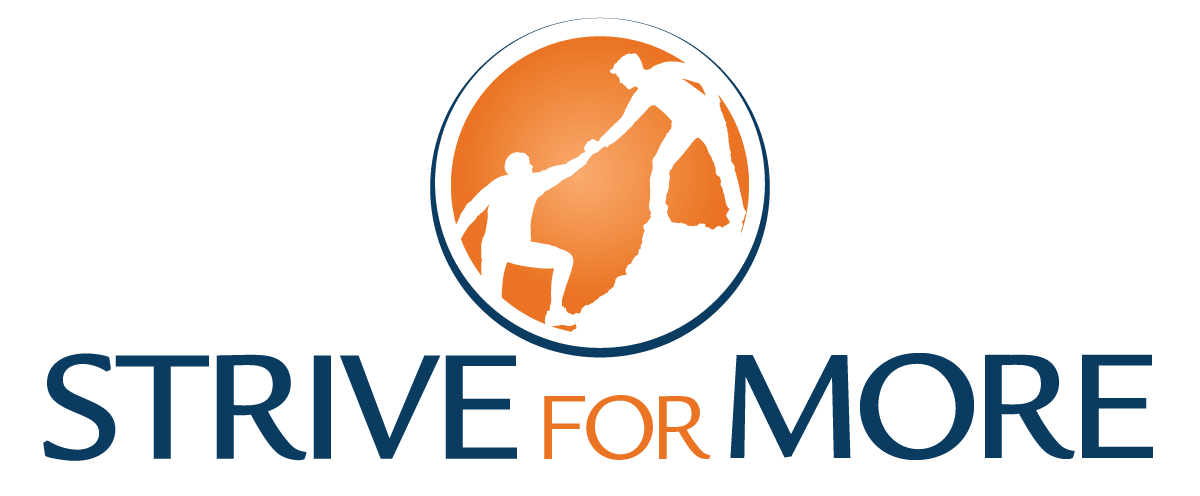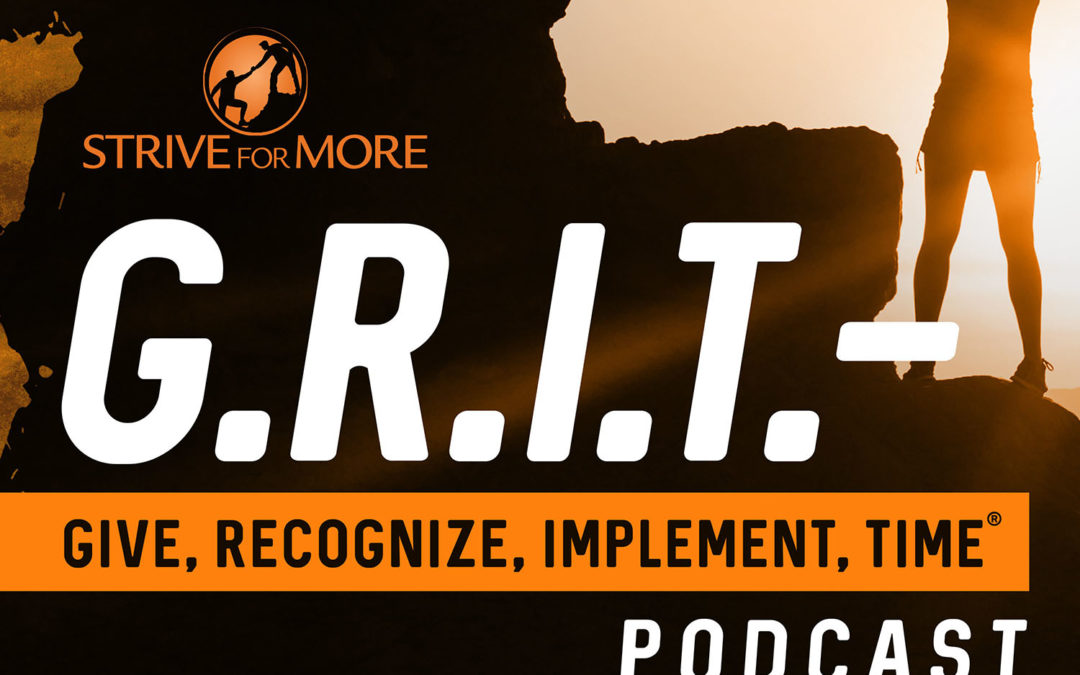Episode Transcript
Welcome back everybody to the G.R.I.T. – Give, Recognize, Implement, Time® podcast. Today, we’re going to dive into the time component of G.R.I.T. So what is it? And simply put, it’s time, literally time.
And it’s a big part of G.R.I.T. because today we are so focused on instant gratification. We want things now, we want to change now. We want everything to happen now, but we don’t change that way fundamentally as human beings. It does take time for us to change, to build new homes, habits, to overcome behaviors we want to modify. To come out from underneath limiting beliefs that we have perhaps about ourselves. Or to learn a different way of communicating with others.
Those changes for us as human beings takes time. And the science behind that is over our experiences in our life, we start to build in new behaviors, beliefs, thought patterns, ways of interacting with folks, that become solidified in neural pathways. And a neural pathway is essentially just a chain of neurons or brain cells in our brain that are associated with, a say, certain action or behavior.
Prime example of that is learning to drive. We create these neural pathways to say, “I want to drive,” to me actually physically going through the motions to do that. I get into the car, put my foot on the brake, turn the car on. Get my hands onto the wheel, check my mirrors, put my foot on the gas and start pressing the gas pedal, once I’m in reverse. And then getting the out of this space.
So we essentially have that thought of, “Oh, I’m going to drive,” that then lights up these neurons and that neural pathway in your brain, translating into, “I have actually done these actions to drive.” When we want to, say, shift that, we not only need to build in new neural pathways, but we need to combat the old one.
So maybe I’ve driven a certain way for 30 years and I have to learn a new wave of driving. I actually have to physically create now a new neural pathway in my brain that says, “Here’s how I’m going to drive now.” And I have to lessen and weaken the older one that says, “Here is how I have been driving.” And then eventually have them flip-flop so that the new way of driving takes hold and is firmly and strongly implanted in our brains, versus the old neural pathway, which now becomes weaker.
And that’s part of just … Essentially the brain as a muscle, is we actually will create and strengthen new neural pathways as we engage in something more and more. And we will lessen and weaken order in our pathways as we engage in that less and less. So when it comes to our behaviors, our communication styles, our thoughts or overcoming limiting beliefs that we have, not only do we have to build the new way of thinking, the new way of communicating, the new way of acting. We also have to come back and lessen the old way.
So it takes time to do that, but it even takes more time upfront as well to understand, “Well, where am I today? Where do I want to be? And what is that new way of, say, communicating that I want to have happen.” That’s what the earlier stages of GRIT are really all about is uncovering that, creating awareness, understanding those mentalities that will dictate our success or not.
And the implement stage is about taking it one small step at a time. And that does take literally time to do it once, then twice, then three times, then four times. And as we take those small actions, we start building in that new neural pathway and making it stronger and stronger and stronger. And the more that we engage in that and the less we engage in the old way of, say, thinking, believing, communicating, we lessen that older neural pathway until there is that shift.
So it’s really just time for us as human beings to change. But like I said, we always have this perception or can have this perception of, “I don’t have enough time.” Or maybe, “I have too much time,” or, “There isn’t time to do this.” And what are your perceptions of time?
And that’s a exercise I’d love to throw out there for you is my perception of time. What are they? Writing out those perceptions, bringing awareness to them can help us really uncover, well, what are maybe those preconceived notions I have about time that can dictate whether I actually give myself the permission to take time to change. Do I feel like I never have enough time? Do I feel like I have too little time? How often do I feel like I actually have the right amount of time? Have I put pressure on myself to change immediately? “I want to make this change and I want it to happen now. I don’t want to wait for it.”
Is that perhaps a perception? What are your perceptions about time? So in this exercise, just a simple heading of, “My perceptions of time.” And Underneath it just writing out what are those perceptions? Do I have enough? Do I have too little? Is there never enough? Maybe I can’t even possibly consider taking the time to make this change, if it doesn’t happen in five minutes. Have I perhaps created artificial stress intention within myself by inflating a deadline of, “I have all these things to do. I want to get them done now,” but there is no maybe actual deadline for it. I’ve just put extra stress and tension on myself by wanting it to come to fruition tomorrow.
Knowing and understanding our perceptions of time can really help alleviate stress and tension within us, and then allow us to have that freedom and that permission to take the time to truly bring about the change that we do seek in life. There’s a lot of great sayings out there like, “Rome wasn’t built in a day.” And a perfectly exemplify the fact that it does literally take time for us to change. And that’s okay, because we all share in that condition.
Another great example of that, I often get asked about my running from folks that I work with, on running and doing training plans of. And how can you run that faster at that level or this pace, “Why am I not there?” And I share the story with them, and I’m going to share that with you now is when I first started running, I could barely run a quarter mile, let alone a half a mile or a mile.
It’s because I hadn’t practiced running. I hadn’t even worked towards it. And it took me a long time to really get comfortable in running, running longer distance. So when I first started running, I only shot for a mile and a half max, because that’s what was on my fitness test as part of my requirements to apply to become an FBI agent. I had to meet physical standards and fitness requirements to get in. And then I had to maintain that throughout the FBI Academy as well, but I never really shot for anything over than that. And I did it just because I had to.
But I kept running as an FBI agent to ensure that my fitness was there, and I started doing a little bit longer distance. I started enjoying it a little bit more. I started to get faster and faster. And then I switched it up, did longer runs, did interval runs. Did runs [inaudible 00:08:21] that working on speed. And over the time that I did that, I did eventually get to a point where I have gotten to a place where I am fairly happy with the speed that I have. And running and a lot faster, quite frankly, than when I first started.
And that was about 11 years ago. I think it was when I really started running for fun, and I would say that it took a couple years for me to get the speed level that I’m at now and then shift and grow, and have recently set new records because I continue to work on it. But my point in all of that is I didn’t start off being able to run what I’m able to run now. I had to put that time and the effort into it to build that speed, to build that endurance. And quite frankly, be okay with allowing the time it needed to take to get to where I wanted to go.
I didn’t just start running, say, two days before I had to take the fitness test. I prepared for it. I was at least a year out from when I was thinking about applying to the FBI, for when I actually started to run in preparation for it, knowing that it was going to take time. I gave myself that permission, and I prioritized it as a time that I wanted to take in life and on days. Versus, “Oh, there’s not enough time to do that.” Or, “I can’t even squeeze this in because I’m so hectic.” I allowed myself the permission to give myself the time, not only to change, but to also ensure that it became a priority in my life as well.
So I hope that you guys enjoyed today and took something away about time and learn something about how do we perceive time, and how does that influence maybe my stress and my anxiety, and how do we change as human beings? Is it instantaneous or does it take time? When I look back on my life and I see how I’ve grown and shifted and what I’ve really become good at, was it instantaneous or did it take time to make that happen?
So until the next time, be in the movement in your life, and I hope you guys have a wonderful and pleasant day.
Listen to all of our episodes here.
Learn More About G.R.I.T. – Give, Recognize, Implement, Time®& Find More Actions You Can Take Right NOW!
To learn more about our signature coaching approach which DOES help people all over the world stay focused, overcome, and achieve, please click here.
Want to Assess Your G.R.I.T. – Give, Recognize, Implement, Time® & get a tangible gauge of key human characteristics that WILL make you successful?
Take our G.R.I.T. – Give, Recognize, Implement, Time assessment now and find out!

